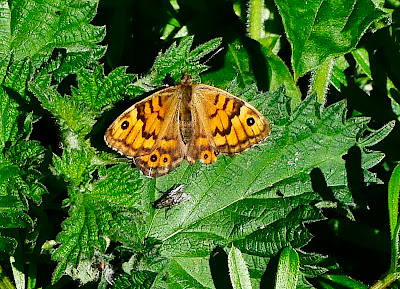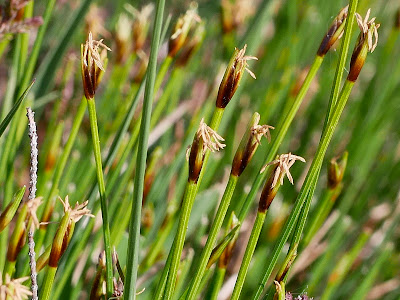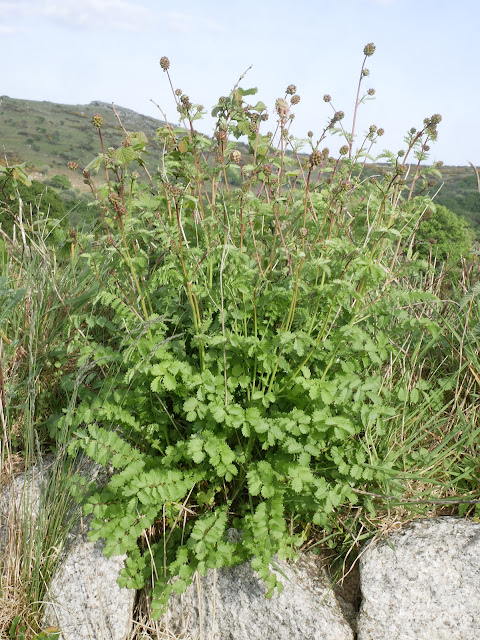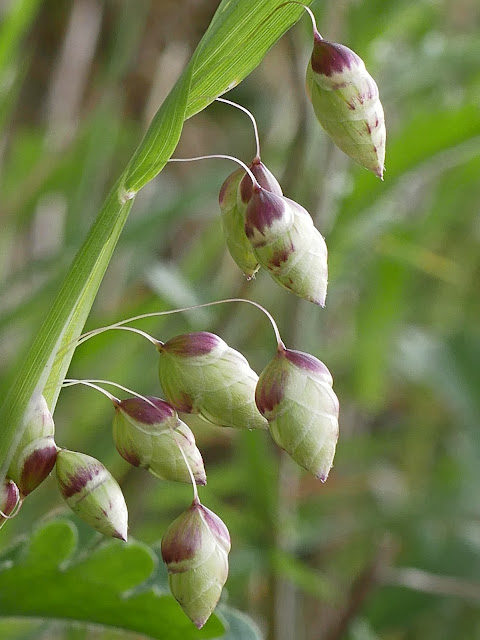May started off the same as April ended, with very hot dry weather. However, the ground hasn't quite dried out and probably never will in many areas of Cornwall. As such, river valleys are always good places to visit for damp loving species and to get out of the heat of the day.
On the first of the month, I took a walk along the River Camel just north of Camelford and stumbled upon a colony of at least 12 hybrid Geums - in particular the hybrid between Wood and Water Avens. This was remarkable as Water Avens is currently only found in the very north east of Cornwall and not in this area. Whilst Wood Avens was plentiful nearby, I could unsurprisingly find no trace of Water Avens. It goes to show that surprises can turn up anywhere. As one might expect they are intermediate between the two species, but they almost always have yellow flowers, with many drooping and not upright. There was a suggestion this could be the hybrid between Large leaved Geum (an American garden plant) and our native Wood Avens, but this is infertile and rare. They are mostly found in Scotland with both parents growing close together. I revisited these plants a while later and took better close up photos and sent them to a BSBI Geum expert, who determined this was indeed G. x intermedium.
Geum x intermedium
A visit to a chip shop in Lanivet produced a pair of Cuckooflowers with huge number of petals on each flower. It seems that the plant continued making petals without any reproductive parts in the centre. There are mostly 12 petals on each flower here with more to open in the centre. These are naturally occuring mutations which the garden trade would collect and clone using cuttings and sell on for gardens. I found two such plants on this verge.
Cardamine pratensis flore pleno
Sedges are starting to flower now, though many are still too young for me (I'm not a Carex expert) to determine. However, more and more species are coming up now and the one below was easy. A series of star like flattened female spikelets in a cliffside bog could only be Star Sedge.
Carex echinata
The first Pignut in flower this year for me. High Cliff, north of Boscastle.
Conopodium majus
Hawthorn coming into flower in early May, as it normally does. Note the single style in the centre. If all flowers had 2 or more styles you have found Midland Hawthorn. Some flowers with one and others with two is the hybrid between Midland and the normal Hawthorn.
Crataegus monogyna
Hedgerow Cranesbill coming into flower on a road verge.
Geranium pyrenaicum
Creeping Forget-me-not in a cliffside bog habitat. This has pale blue flowers; sepals shaped like long sided triangles; long hairs sticking out near the base of the plant and hairs pressed flat nearer the flowers. Looking at these parts of a plant will help you identify all of the water loving Forget-me-nots, so take notes of the specimen you might find.
Myosotis secunda
Although around 30 or so Early Purple Orchids have been in flower a while near my home, I've not stopped and photographed them. However, on a trip near Boscastle, I found 33 flowering spikes on a Cornish hedge and road verge. A lovely sight, so I gave in and took some photos, like you do!
Orchis mascula
Lousewort steals nutrients from nearby plants, though it does photosynthesise some of its own food. Cliffside bog habitat, but also present on dry heaths now.
Pedicularis sylvatica
On the same cliff habitat were thousands of Heath Milkwort. The flowers were mostly a deep blue, but a few were all white. The flowers look the same in several Milkwort species, so to determine these from Common Milkwort, you need to check the lowest leaves: Alternate = Common Milkwort: Opposite = Heath Milkwort.
Polygala serpyllifolia
And what it looks like on the ground.
Some other interest from this trip was a Drinker Moth caterpillar. As it was static on Hemlock Water-Dropwort, I wondered if it had eaten some of it and was dead! Or perhaps it was about to pupate.
Euthrix potatoria
Wall Brown butterfly
Lasiommata megera
Whilst too early for the rarer clovers, I had a chance for a quick look around at The Lizard and Kynance Cove in early May, here's some of the plants I found.
Dropwort flowering in a recently scrub cleared area.
Filipendula vulgaris
The Lizard village car park is always a reliable place to find Cornish Ramping Fumitory, endemic to the county and the UK's largest flowering fumitory. Note that the top petals start off white and turn pink after pollination.
Fumaria occidentalis
All the coastal cliffs in the area had Hairy Greenweed coming into flower. This has small hairy leaves and is always procumbent (close to the ground) with flowers along the stem and not just at the terminal end of the stalk like Dyer's Greenweed has. The keel of the flowers are also hairy.
Genista pilosa
Western Clover is restricted to the Western coasts of the UK as the name suggests, but this was flowering well, with lots of plants seen around exposed boulders and short turf. I've included a photo of the leaves too, which are much smaller than White Clover and unmarked.
We then drove to Mousehole (pronounced Mowzel) and I found some Least Yellow Sorrel growing on the harbour wall, a new record for the area too. The small single flowers; pale green leaves and only 5 stamens with anthers, separate this from Procumbent Yellow Sorrel which is the commonest find in urban areas.
Also of note were a few of the native Narrow-leaved Vetch which are usually coastal and are much smaller than the Common Vetch one usually sees. They also have more or less the same colour standard and side petals and very narrow delicate leaves.
Round-leaved Water Crowfoot in a dried up pond, which means it will seed and die off rather than flower for weeks. Such is the way most springs of late with 2-4 week droughts becoming commonplace at this time of the year.
On my way home, I recorded a monad I had previously recorded in late Summer. Of course, I found many more species as it was a different time of year to my last visit. However, there were two surprises, both growing on top of a 6 foot high Cornish hedge. The first was the non native subspecies of Salad Burnet likely introduced to the area when the main A30 was modified. This plant was also scattered around the road verges.
The second was a garden escape called London Pride. I have recorded this as escaped elsewhere, but usually very close to a house or garden; not this time. The flowers remind me of Starry Saxifrage that I found in Snowdonia years back.
One of my favourite small plants is Hairy Birdsfoot Trefoil. It's hard to spot them when not in flower, but the deep yellow, egg yolk colour of the flowers make them easy to spot when flowering. Confined to short turf in coastal areas.
The first of the not so common Clovers were flowering, the one below being Subterranean Clover. There was a pasture field with thousands of flowers in it, though the flowers are at most about 5mm tall!
Below is Common Milkwort which can have (and did) white, blue, pink or purple flowers. In this species, all the stem leaves are alternate right to the base.
A couple of days later, I recorded the St. Neot area just south of Bodmin Moor. Here's some of the plants I found there. In towns, it is common to find garden escapes and the first two plants I've featured, have self seeded onto walls in the village; Garden Ladies Mantle and Snapdragon.
The pink form of White Clover; it's the second time I have found this recently. To separate it from Alsike Clover, simply check the leaf stems. If you see any roots at the leaf nodes it's definitely White Clover as Alsike Clover does not root at the nodes. That's easier than checking the angles and variations of leaf veins as the books suggest you do to separate them.
Just West of St. Neot is Goonzion Downs where I found the first of this year's Heath Spotted Orchids in flower. I'm surprised any make it, as the place is overgrazed by a mixture of highland cattle, sheep and ponies.
Dactylorhiza maculata subsp ericetorum
Creeping Forget-me-not from a wet area on Bodmin Moor in an evening recording trip.
This species has pale blue flowers, smaller than the other water forget-me-nots with patent (sticking out) hairs at the base of the stem and appressed (flattened) hairs at the top of the stem. Another difference is that the sepals are in the shape of a triangle and they have longer sides than across the base. This one also sends out stolons, so forms dense stands, sometimes in almost straight lines along a stream or ditch.
Myosotis secunda
Ivy-leaved Crowfoot from a boggy roadside on Bodmin Moor.
Ranunculus hederaceus
That ends the first half of May, apparently one of the driest and warmest on record, though accurate weather records only go back a couple of hundred years, but still, this is the fourth spring drought year out of the last five. I expect native plants will adapt and also some non natives will find the heat and dryness to their liking too. Some plants won't and will struggle. That's what recording plants is all about, as it shows trends over time, both good and bad. The next instalment will be published at the beginning of June, see you then.
Take Care
Dave






































































No comments:
Post a Comment
All comments are moderated before publication, so please don't bother spamming me, thank you. Genuine comments most welcome.